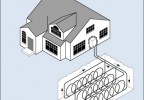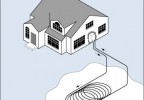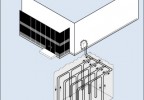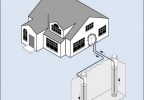Geothermal Heat Pumps: Real Energy Savings or Hype?
Can geothermal power save the average homeowner money and energy? Jeff Wilson shares his experience.
Way back in 1980, my dad installed a geothermal heat pump in our new, passive-solar home. Dad was a civil engineer and explained, with obvious enthusiasm, how our new ground-source heat pump (GSHP) would use one unit of electricity to liberate three units of heat from the ground, which we would use to heat our home in the winter. Then, in the summer, the GSHP would do the reverse, drawing heat out of our home and storing it in the ground. Like a big battery, our system would use the earth as a heat source and heat sink, saving lots of energy along the way.
GSHPs come in four basic flavors – Horizontal Closed Loop, Vertical Closed Loop, Lake Closed Loop, and Open Loop (or well-based). That old heat pump in my family’s home was an open loop system that drew groundwater from deep underground, extracted heat from or dumped heat into the water, and then pumped that water outside. (That, by the way, created a very convenient small stream that ran through the horse field and back into the swamp behind the house, liberating me from ever having to fill the water trough at the barn again. Believe me, a 15-year-old can get pretty excited about GSHPs when it liberates him from the hard labor of hauling water.)
Most systems installed these days are one of the three closed-loop varieties. If you have enough land, horizontal closed loop systems can be installed by using earth-moving equipment. In places where land is scarcer, like neighborhoods in town, vertical closed loops are installed by using drilling equipment. Due to the use of drilling equipment, these installations are generally more expensive than horizontal closed loop systems. The last type of system, a lake closed loop, requires little digging at all but simply uses a submerged loop in a nearby pond or lake. This last type is the least expensive of all the GSHPs.
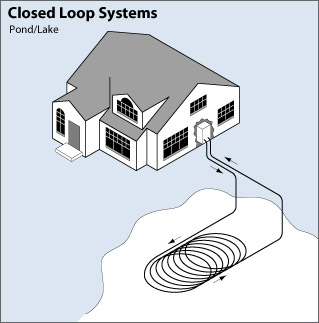
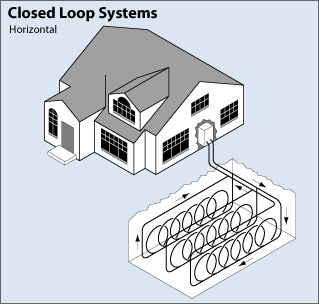
With the loop installed, the mechanical parts of a GSHP are installed entirely within the home. With traditional air-source heat pumps (ASHPs) and air-conditioners, a condenser (i.e., the noisy thing with the fan that sits next to your deck) is located outside of the home. A GSHP doesn’t require an outdoor condenser, because the buried ground loop serves that purpose, so a GSHP is much quieter than a traditional system. Also, because the mechanical parts of a GSHP aren’t subject to the volatile outdoor environment, GSHP equipment lasts longer – up to 25 years compared with 15 for standard equipment. The ground loops themselves, made of polyethylene, are typically warranted for 50 years, so when GSHP mechanical equipment needs to be replaced, the old loops can be reused, resulting in a lower long-term cost for geothermal equipment when compared with other technology.
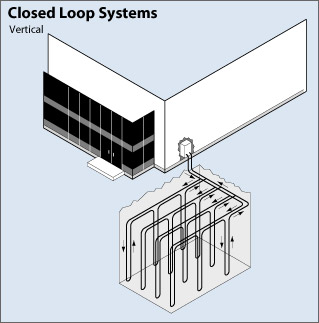
That said, there’s a lot of hype built around GSHPs – manufacturers routinely overstate the Coefficient of Performance (COP) of their units, making apples-to-apples comparisons difficult. The measurement of COP is simply a multiplier of how much heating energy is delivered by the unit to the home compared with the initial, primary energy (in the case of a heat pump, the electricity used to run the pumps, compressors, and fans). To oversimplify it, an electric resistance heater will have a COP of 1 because it will turn 1 watt of incoming electricity directly into 1 watt of equivalent heating energy. Independent testing gives most GSHPs a COP of 3, meaning that for an input of 1 watt of electricity, the unit delivers the equivalent of 3 watts of heating. However, many manufacturers claim COPs of 4 or 5 because they selectively leave out the energy use of the pumps that move water through the loops of the system. If you’re serious about computing the payback period for a GSHP, make sure to rely on independent evaluations of COPs.
The Environmental Protection Agency (EPA) calculates that a GSHP can deliver energy savings of 44% over ASHPs and up to 72% over electric resistance heating and standard air-conditioning. GSHPs also help to maintain a relative humidity of 50%, which makes them of particular interest in hot, humid regions that require lots of cooling and dehumidification. The installation of an optional “desuperheater” can make the economics of GSHPs even more compelling (although, to be fair, some ASHP manufacturers offer hot water solutions as well). This device uses waste heat from the system to pre-heat domestic hot water, saving energy and money on that front as well. All of this energy savings is why the federal government is willing to offer a 30% tax credit (not a deduction, but a dollar-for-dollar reduction of your tax bill) on equipment, drilling, installation, and landscape repair for GSHP systems.

Payoff times vary, but typically range from 2 to 10 years, depending on the type of equipment being replaced. However, many in the industry are skeptical of the value of GSHPs over modern ASHPs, particularly ASHPs of the ductless mini-split variety. The reasoning goes like this – GSHPs are extremely complicated pieces of equipment that are essentially built on site. The competency of the installer is paramount and the opportunity for mistakes is large. Ductless mini-split ASHPs are extremely simple to install, relatively inexpensive, and simpler to repair and replace. In many cases, especially in smaller, well insulated, and air-sealed homes, the economic benefits of GSHPs over ductless mini-split ASHPs may disappear.
The bottom line? Think critically before taking a manufacturer’s promises at face value. Don’t just compare a new GSHP to your old oil-fired boiler but also to other rival technology. In the end, it’s your energy dollar, so spend it wisely.

Jeff Wilson
Jeff Wilson, author of The Greened House Effect and host of Buildipedia's Everyday DIY series, many HGTV and diy network shows and 25-year veteran of the construction industry, lives with his wife and two daughters in a perpetually half-renovated home in a small college town in Ohio. You can see Jeff’s most recent project, the Deep Energy Retrofit of his 1940’s Cape Cod style home at thegreenedhouseeffect.com.
Website: www.jeffwilsonregularguy.com
